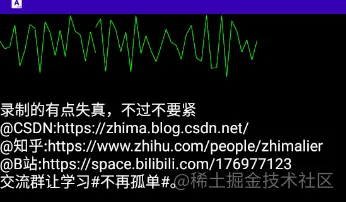目录 实践过程 SurfaceView属性和方法 TextureView属性和方法 TextureView示例 SurfaceView示例 实践过程 SurfaceView属性和方法 surfaceCreated(@NonNull SurfaceHolder holder) :surface创建时回调 surfaceDestroyed(@
目录
- 实践过程
- SurfaceView属性和方法
- TextureView属性和方法
- TextureView示例
- SurfaceView示例
实践过程
SurfaceView属性和方法
- surfaceCreated(@NonNull SurfaceHolder holder):surface创建时回调
- surfaceDestroyed(@NonNull SurfaceHolder holder):surface销毁时回调
- surfaceChanged(@NonNull SurfaceHolder holder, int format, int width, int height):surface发生变化时回调
- SurfaceHolder.addCallback(context):添加回调,也就是上面三个方法
- lockCanvas():获取Canvas对象并锁定画布,调用Canvas进行绘图,和unlockCanvasAndPost是依次成对出现。
- unlockCanvasAndPost():结束锁定画布,并且提交改变。和lockCanvas是依次成对出现。
TextureView属性和方法
- getSurfaceTexture():此方法返回此视图使用的 SurfaceTexture。
- getBitmap(整型宽度,整型高度):此方法返回返回关联表面纹理内容的位图表示形式。
- getTransform(Matrix transform):此方法返回与此纹理视图关联的转换。
- isOpaque():此方法指示此视图是否不透明。
- lockCanvas():此方法开始编辑曲面中的像素。
- setOpaque(boolean opaque):此方法指示此纹理视图的内容是否不透明。
- setTransform(Matrix transform):此方法将转换设置为与此纹理视图关联。
- unlockCanvasAndPost(Canvas canvas):此方法完成对曲面中像素的编辑。
- onSurfaceTextureAvailable(SurfaceTexture arg0, int arg1, int arg2):创建的监听,前提开启硬件加速
- onSurfaceTextureDestroyed(SurfaceTexture arg0):销毁的监听
- onSurfaceTextureSizeChanged(SurfaceTexture arg0, int arg1,int arg2):变化的监听
- onSurfaceTextureUpdated(SurfaceTexture arg0):更新的监听
TextureView示例
public class MainActivity extends Activity implements SurfaceTextureListener{
private Camera mCamera;
private TextureView [mTextureView]();
protected void onCreate(Bundle savedInstanceState) {
super.onCreate(savedInstanceState);
mTextureView = new TextureView(this);
mTextureView.setSurfaceTextureListener(this);
setContentView(mTextureView);
}
public void onSurfaceTextureAvailable(SurfaceTexture surface, int width, int height) {
mCamera = Camera.open();
try {
mCamera.setPreviewTexture(surface);
mCamera.startPreview();
//可以修改透明度和旋转方向
mTextureView.setAlpha(1.0f);
mTextureView.setRotation(90.0f);
} catch (IOException ioe) {
// 异常处理
}
}
public void onSurfaceTextureSizeChanged(SurfaceTexture surface, int width, int height) {
}
public boolean onSurfaceTextureDestroyed(SurfaceTexture surface) {
mCamera.stopPreview();
mCamera.release();
return true;
}
public void onSurfaceTextureUpdated(SurfaceTexture surface) {
}
}
SurfaceView示例

Java版本自定义
public class ECGSurfaceViewJava extends SurfaceView implements SurfaceHolder.Callback {
//简单模拟一下数据
public List<Integer> ecgDatas = new ArrayList<>();
//矩阵 画布 画笔 颜色
private Rect rect;
private Canvas mCanvas;
private Paint mPaint; //画波形的画笔
private String line_color = "#01FC00"; //画笔默认是绿色的
private int wave_speed = 30;//定义波速:30mm/s
private int sleepTime = 8;//每次锁屏的时间间距,单位ms 连线的时间长度,,如果大则会卡顿效果
private SurfaceHolder surfaceHolder;
private boolean isCanRun = true;
private int mStartX = 0;
private int mStartY = 0;
private Runnable drawRunnable = new Runnable() {
@Override
public void run() {
while (isCanRun) {
//在这获取改view的宽度 如果mStartX超过则归位 这样实现反复从头画,我这800只是简单表示下效果
if (mStartX > 800) {
mStartX = 0;
}
//绘制区域不断向右变化
rect.set(mStartX, 0, mStartX + 16, 300);
mCanvas = surfaceHolder.lockCanvas(rect); //提交绘制区域
if (mCanvas == null) return;
//很重要,如果反复从头绘制,会覆盖上一次的绘制
mCanvas.drawColor(Color.TRANSPARENT, PorterDuff.Mode.CLEAR);
if (ecgDatas.size() > 0) {
mCanvas.drawLine(mStartX, mStartY, mStartX + 16, ecgDatas.get(0), mPaint);
//这个点的重点是下一个点的起点
mStartX = mStartX + 16;
mStartY = ecgDatas.get(0);
ecgDatas.remove(0);
} else {
initData();
}
surfaceHolder.unlockCanvasAndPost(mCanvas); //这种方式把上次绘制的遮盖了 因此出现了断点
}
}
};
public ECGSurfaceViewJava(Context context, AttributeSet attrs) {
super(context, attrs);
this.surfaceHolder = this.getHolder();//获取holder
this.surfaceHolder.addCallback(this);
rect = new Rect(); //绘制矩阵内
mPaint = new Paint();
mPaint.setColor(Color.parseColor(line_color)); //画笔颜色
mPaint.setAntiAlias(true); //抗锯齿
mPaint.setStrokeWidth(2);
initData();
}
private void initData() {
ecgDatas.clear();
for (int i = 0; i < 200; i++) {
ecgDatas.add((int) (Math.random() * 200));
}
mStartY = ecgDatas.get(0);
}
@Override
public void surfaceCreated(SurfaceHolder holder) {
new Thread(drawRunnable).start();
}
@Override
public void surfaceChanged(SurfaceHolder holder, int format, int width, int height) {
}
@Override
public void surfaceDestroyed(SurfaceHolder holder) {
isCanRun = false;
}
}
Kotlin版本自定义
class ECGSurfaceViewKotlin(context: Context?, attrs: AttributeSet?) : SurfaceView(context, attrs), SurfaceHolder.Callback {
//简单模拟一下数据
var ecgDatas: MutableList<Int> = ArrayList()
//矩阵 画布 画笔 颜色
private var rect: Rect? = null
private var mCanvas: Canvas? = null
//画波形的画笔
private var mPaint: Paint? = null
private val line_color = "#01FC00" //画笔默认是绿色的
private val wave_speed = 30 //定义波速:30mm/s
private val sleepTime = 8 //每次锁屏的时间间距,单位ms 连线的时间长度,,如果大则会卡顿效果
var surfaceHolder: SurfaceHolder? = null
private var isCanRun = true
private var mStartX = 0
private var mStartY = 0
private val drawRunnable = Runnable {
while (isCanRun) {
//在这获取改view的宽度 如果mStartX超过则归位 这样实现反复从头画,我这800只是简单表示下效果
if (mStartX > 800) {
mStartX = 0
}
//绘制区域不断向右变化
rect!![mStartX, 0, mStartX + 16] = 300
mCanvas = surfaceHolder!!.lockCanvas(rect) //提交绘制区域
if (mCanvas == null) return@Runnable
//很重要,如果反复从头绘制,会覆盖上一次的绘制
mCanvas!!.drawColor(Color.TRANSPARENT, PorterDuff.Mode.CLEAR)
if (ecgDatas.size > 0) {
mCanvas!!.drawLine(mStartX.toFloat(), mStartY.toFloat(), (mStartX + 16).toFloat(), ecgDatas[0].toFloat(), mPaint)
//这个点的重点是下一个点的起点
mStartX = mStartX + 16
mStartY = ecgDatas[0]
ecgDatas.removeAt(0)
} else {
initData()
}
surfaceHolder!!.unlockCanvasAndPost(mCanvas!!) //这种方式把上次绘制的遮盖了 因此出现了断点
}
}
init {
surfaceHolder = this.holder //获取holder
surfaceHolder!!.addCallback(this)
rect = Rect() //绘制矩阵内
mPaint = Paint()
mPaint!!.setColor(Color.parseColor(line_color)) //画笔颜色
mPaint!!.setAntiAlias(true) //抗锯齿
mPaint!!.setStrokeWidth(2f)
initData()
}
private fun initData() {
ecgDatas.clear()
for (i in 0..199) {
ecgDatas.add((Math.random() * 200).toInt())
}
mStartY = ecgDatas[0]
}
override fun surfaceCreated(holder: SurfaceHolder?) {
Thread(drawRunnable).start()
}
override fun surfaceChanged(holder: SurfaceHolder?, format: Int, width: Int, height: Int) {
}
override fun surfaceDestroyed(holder: SurfaceHolder?) {
isCanRun = false
}
}
布局直接使用即可:
<cn.appstudy.customView.ECGSurfaceViewJava
android:layout_width="match_parent"
android:layout_height="200dp"/>
<cn.appstudy.customView.ECGSurfaceViewKotlin
android:layout_width="match_parent"
android:layout_height="200dp"
android:layout_marginTop="220dp" />
上面小空只是简单写了下示例,如果是画心电图其实还有更多的逻辑,比如多个心电图同步,比如超出屏幕后回到起始位置,比如实时更新心电图数据,再比如心电图速度控制等等。
而且上面心电图示例是从左到右的,还有可能从上到下,从右到左的等等,更多功能就交给大佬们去开发了。
到此这篇关于Android 中TextureView和SurfaceView的属性方法及示例说明的文章就介绍到这了,更多相关Android extureView和SurfaceView 内容请搜索自由互联以前的文章或继续浏览下面的相关文章希望大家以后多多支持自由互联!
